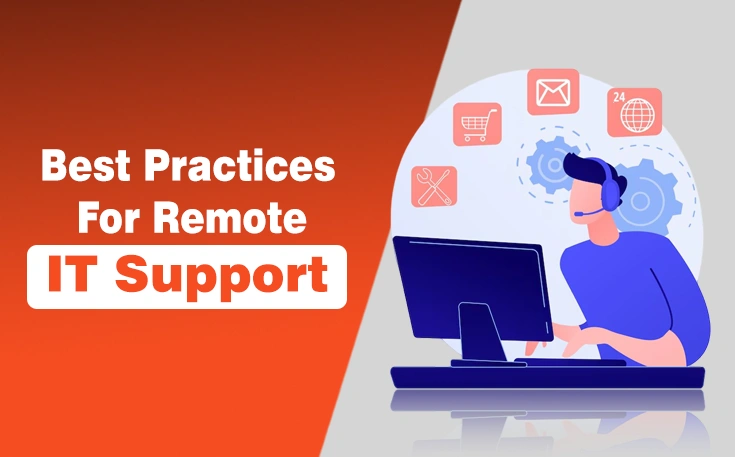Have you ever faced a tech issue that stopped you in your tracks? IT support is essential for keeping business operations smooth, whether a sluggish computer, a connectivity problem, or software that refuses to cooperate.
With remote work becoming the norm, businesses need reliable ways to assist employees no matter where they are. This is where remote IT support software proves invaluable, allowing IT teams to troubleshoot and fix issues in real time without being physically present.
To make remote support efficient and stress-free, here are the best practices ensuring that IT teams and employees have a seamless experience.
What Is Remote IT Support?
Remote IT support is the process of providing technical assistance and resolving IT-related issues for individuals, teams, or organizations.
It specialists provides this support through remote IT support software that allows IT professionals to access and control remote devices, such as computers or mobile phones, to diagnose and resolve issues.
How it works:
- It specialists use specialized software to establish a secure connection to the user’s device.
- They can then view the user’s screen, take control of the keyboard and mouse, and perform necessary actions to resolve issues.
- This allows for faster and more efficient troubleshooting compared to traditional methods, where technicians need to be physically present.
What are the Benefits of Remote IT Support?
Remote IT support offers a lot of benefits for both businesses and individuals. Here’s why it’s a great choice:
1. Quick Response Time
One of the remote It support is quick issue resolving. IT professionals don’t need to travel to your location, so they can quickly connect to your devices and start solving problems right away.
2. Cost-Effective
Remote support is cost effective as it saves many expenditures like traveling cost, on-site expenses and office bills. This makes it much cheaper than traditional IT support, especially for small businesses or individuals.
3. Convenience
You don’t need to leave your home or office to get help. IT experts can connect to your computer or network remotely and fix issues, which means you can keep working without disruption.
4. Access to Expert Help
Remote IT support gives you access to a wide range of experts, even if they’re not local. This means you can get specialized support for all kinds of tech problems, no matter where the support team is based.

5. Reduced Downtime
Since problems are fixed quickly, remote IT support helps reduce downtime. This is especially important for businesses where downtime can lead to lost productivity and revenue.
6. Security and Privacy
Remote IT professionals use secure methods to access your systems, ensuring that your data stays safe. They can also help you set up better security measures to protect against future issues.
5 Best Practices for Remote IT Support
Here are the 5 best practices for seamless Remote IT support you need to know:
1. Ensure Secure Access for Remote Support
Security should always be a priority when providing IT assistance from a distance. Without proper safeguards, remote access can become a target for cyber threats. IT teams should use secure connections with end-to-end encryption to protect sensitive data.
Multi-Factor Authentication (MFA) adds another layer of security, ensuring that only authorized users can initiate remote sessions.
Additionally, setting up role-based access control prevents unnecessary exposure of critical systems. Employees who know their data is secure will feel comfortable receiving remote assistance.
2. Communicate Clearly and Effectively
Technical issues can be frustrating, especially for employees who are unfamiliar with troubleshooting steps. IT professionals should explain problems and solutions using simple, jargon-free language. Providing clear instructions before taking control of a user’s system can make the process feel less invasive.
A step-by-step approach and regular updates on progress keep employees informed and engaged. If a solution requires additional time, setting expectations helps reduce frustration. Communication isn’t just about solving the issue—it’s about ensuring users feel supported throughout the process.
3. Leverage Automation for Faster Resolution
Some IT issues, such as password resets, software updates, or system diagnostics, are repetitive. Automating these common tasks can free up IT teams for more complex issues. Many remote support tools have built-in automation features for maintenance without manual intervention.
Automated alerts can notify IT staff of potential issues before they escalate, reducing employee downtime. By incorporating automation, businesses improve response times and allow IT teams to focus on more pressing concerns.
4. Maintain Detailed Session Logs for Accountability
Keeping records of remote support sessions is essential for security, compliance, and troubleshooting. A good practice is to log every remote interaction, noting what actions were taken and any changes made to the system.
These logs help IT teams track recurring issues and refine their support strategies. They also provide transparency, ensuring employees and management can review past support sessions if needed. Having a well-documented support history makes it easier to identify patterns and improve overall IT efficiency.
5. Provide Ongoing Training for Employees
Many IT issues stem from simple user errors, such as clicking on phishing emails or misconfiguring software settings. Providing employees with basic cybersecurity awareness and troubleshooting skills can reduce the number of preventable support requests.
Regular training sessions or easy-to-follow guides empower employees to fix minor problems independently, allowing IT teams to focus on more critical issues. Encouraging a culture of tech awareness strengthens security and enhances overall productivity.
Companies looking to optimize their remote support capabilities can turn to ConnectWise for a robust solution that ensures seamless and secure IT assistance.
How to Choose the Best Remote IT Support Provider?
It is important to choose the best Remote IT support provider so that you can get the right level of services and support for your needs. Here are 5 steps to make the right choice:
1. Check Their Experience and Expertise
It is important to always look for a provider with a solid track record in handling the specific IT issues you might face. No matter whether it’s troubleshooting software problems, network issues, or data security, make sure they have the expertise in your area of need. The more experienced they are, the better they can resolve your problems quickly.
2. Analyze Their Response Time
Response time is the most important factor to keep in mind, especially when you’re dealing with technical problems that need quick fixes. You can ask about their average response time and how soon they can address an issue once it’s reported. A fast response time can minimize downtime, keeping your systems running smoothly.
3. 24/7 Availability
Tech issues can arise at any time, so it’s beneficial to choose a provider that offers round-the-clock support. If you work outside regular business hours or across different time zones, 24/7 availability ensures you’re covered at all times.
4. Look for Clear Communication
Good communication is key. You want to make sure that the IT support provider can explain technical issues and solutions clearly, without using too much jargon. You should feel confident that you understand what’s going on with your systems and how it’s being fixed.
5. Check for Security Measures
Security is a top priority when dealing with remote IT support. Ensure that the provider follows strict protocols for accessing your systems, such as encrypted connections and secure login methods. They should also help you strengthen your own security to prevent future issues.
Sum Up
Well, all these details are about remote IT support to streamline IT efficiency. With quick, remote support, cost-effective, and convenient solutions, remote support helps businesses stay productive while ensuring high-level security and expertise.
A strong remote IT support system keeps businesses running smoothly by resolving technical issues quickly and securely. Prioritizing security, clear communication, automation, session tracking, and user training creates an environment where employees and IT teams thrive.





